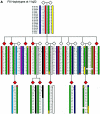Attention-deficit/hyperactivity disorder in a population isolate: linkage to loci at 4q13.2, 5q33.3, 11q22, and 17p11
- PMID: 15497111
- PMCID: PMC1182160
- DOI: 10.1086/426154
Attention-deficit/hyperactivity disorder in a population isolate: linkage to loci at 4q13.2, 5q33.3, 11q22, and 17p11
Abstract
Attention-deficit/hyperactivity disorder (ADHD [MIM 143465]) is the most common behavioral disorder of childhood. Twin, adoption, segregation, association, and linkage studies have confirmed that genetics plays a major role in conferring susceptibility to ADHD. We applied model-based and model-free linkage analyses, as well as the pedigree disequilibrium test, to the results of a genomewide scan of extended and multigenerational families with ADHD from a genetic isolate. In these families, ADHD is highly comorbid with conduct and oppositional defiant disorders, as well as with alcohol and tobacco dependence. We found evidence of linkage to markers at chromosomes 4q13.2, 5q33.3, 8q11.23, 11q22, and 17p11 in individual families. Fine mapping applied to these regions resulted in significant linkage in the combined families at chromosomes 4q13.2 (two-point allele-sharing LOD score from LODPAL = 4.44 at D4S3248), 5q33.3 (two-point allele-sharing LOD score from LODPAL = 8.22 at D5S490), 11q22 (two-point allele-sharing LOD score from LODPAL = 5.77 at D11S1998; multipoint nonparametric linkage [NPL]-log[P value] = 5.49 at approximately 128 cM), and 17p11 (multipoint NPL-log [P value] >12 at approximately 12 cM; multipoint maximum location score 2.48 [alpha = 0.10] at approximately 12 cM; two-point allele-sharing LOD score from LODPAL = 3.73 at D17S1159). Additionally, suggestive linkage was found at chromosome 8q11.23 (combined two-point NPL-log [P value] >3.0 at D8S2332). Several of these regions are novel (4q13.2, 5q33.3, and 8q11.23), whereas others replicate already-published loci (11q22 and 17p11). The concordance between results from different analytical methods of linkage and the replication of data between two independent studies suggest that these loci truly harbor ADHD susceptibility genes.
Figures







References
Electronic-Database Information
-
- ADHD Genetic Research Study, http://www.nhgri.nih.gov/10004331 (for additional data regarding results obtained by different methods of linkage)
-
- Center for Inherited Disease Research, http://www.cidr.jhmi.edu/
-
- deCODE, http://www.decode.com/
-
- Online Mendelian Inheritance in Man (OMIM), http://www.ncbi.nlm.nih.gov/Omim/ (for ADHD) - PubMed
References
-
- Abecasis GR, Cherny SS, Cookson WO, Cardon LR (2002) Merlin—rapid analysis of dense genetic maps using sparse gene flow trees. Nat Genet 30:97–101 - PubMed
-
- Acosta MT, Arcos-Burgos M, Muenke M (2004) Attention deficit/hyperactivity disorder (ADHD): complex phenotype, simple genotype? Genet Med 6:1–15 - PubMed
-
- American Psychiatric Association (1994) Diagnostic and statistical manual of mental disorders, 4th ed. American Psychiatric Association, Washington, DC
-
- Arcos-Burgos M, Castellanos FX, Konecki D, Lopera F, Pineda D, Palacio JD, Rapoport JL, Berg K, Bailey-Wilson J, Muenke M (2004) Pedigree disequilibrium test (PDT) replicates association and linkage between DRD4 and ADHD in multigenerational and extended pedigrees from a genetic isolate. Mol Psychiatry 9:252–259 - PubMed
-
- Arcos-Burgos M, Castellanos FX, Lopera F, Pineda D, Palacio JD, Garcia M, Henao GC, Palacio LG, Berg K, Bailey-Wilson JE, Muenke M (2002) Attention-deficit/hyperactivity disorder (ADHD): Feasibility of linkage analysis in a genetic isolate using extended and multigenerational pedigrees. Clin Genet 61:335–343 - PubMed
Publication types
MeSH terms
LinkOut - more resources
Full Text Sources
Other Literature Sources
Medical

